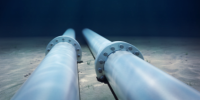2 min read
Optimising the Efficiency of Subsea Installation Maintenance
Kate Aguilera Nov 3, 2023 11:28:30 AM

The Scope
We secured a contract in 2015 with a major international operator to perform a study on a subsea main control umbilical (MCU), servicing two subsea control modules via a junction box under a floating production vessel (FPV). The study was undertaken after a recent remotely operated vehicle (ROV) survey of the MCU identified anomalies with the buoyancy modules.
A review of the footage revealed the umbilical of the first module was missing. The second had split in half but was still tethered to the MCU, sliding up the line and stopping at the base of the third module causing both to slide up towards the hog bend. The remaining modules had all relocated a few meters from their as-laid positions up towards the hog bend.
In order to reinstate buoyancy the client attached two new modules to the MCU. The split module (now redundant with the addition of two new modules) remained tethered to the MCU.
The client requested us to perform a comparative assessment between the current and as-laid umbilical configurations to identify any integrity issues that might occur if the MCU was left untouched. The objectives of the work were to:
- Identify differences in the MCU’s minimum bend radius (MBR) and elevations above seabed between the as-laid and current buoyancy module arrangements; the latter with and without the split module attached
- Conclude whether any remedial work was required to relocate the buoyancy modules back to their as-laid elevations or remove the redundant split module from the line
- Identify any additional concerns raised from the assessment
The Solution
The MCU had been installed in the 1980s and most of its original installation and design documentation was either hard to locate or contradictory. Without the necessary data we proceeded with the comparative study using assumptions in lieu of unknowns. These assumptions, although undesirable, were formulated based on a thorough review of all the available documentation and our extensive knowledge of flexible and umbilical analysis. The pay-out length was hand calculated based on a series of supplied documents and the allowable service MBR was estimated based on our knowledge of similar flexible systems.
An OrcaFlex model was built of the full system which included the subsea template, junction box, MCU, FPV and all necessary buoyancy modules. The subsequent analysis demonstrated that the radius of the hog bend was less than 3m for a range of bending stiffness values at the lower end of the assessed spectrum. This put the hog bend at risk, as typical service MBRs are between 1 and 3m. If the MCU was to operate for long periods in its current configuration, there was a high probability that storm conditions and significant dynamic effects could cause a further reduction in the MBR, leading to failure of the MCU; a costly result from avoidable risk.
Upon completion of the analysis, we made the following recommendations:
- As a minimum the split module should be cut from the line to improve the MBR at the hog bend
- The buoyancy modules should be relocated to their as-laid positions to reduce the risk of compromising the hog bend MBR during service
- Regular general visual inspections of the umbilical should be undertaken as part of the on-going integrity management of the assets. Future unplanned changes to the buoyancy configuration of the MCU should be recorded and reviewed for any potential impact on integrity.
The Benefits
Despite incomplete data, we were able to apply our subsea knowledge and project experience to draw practical conclusions and recommendations, supported by computer based analysis. The analysis and recommendations provided the client with a clear view of the position and integrity of the MCU and the justified needed to take action to avoid operational risks.



